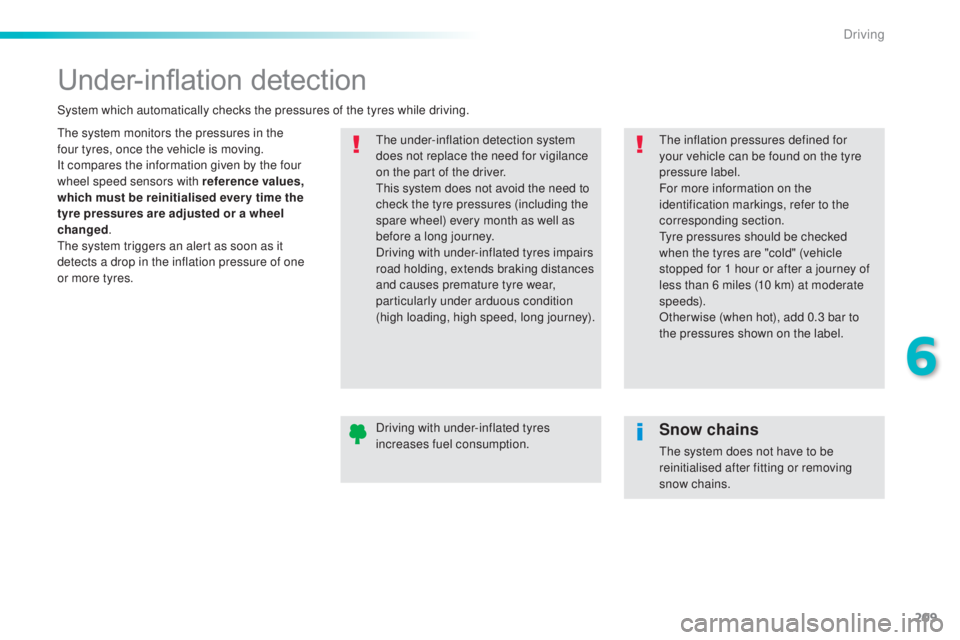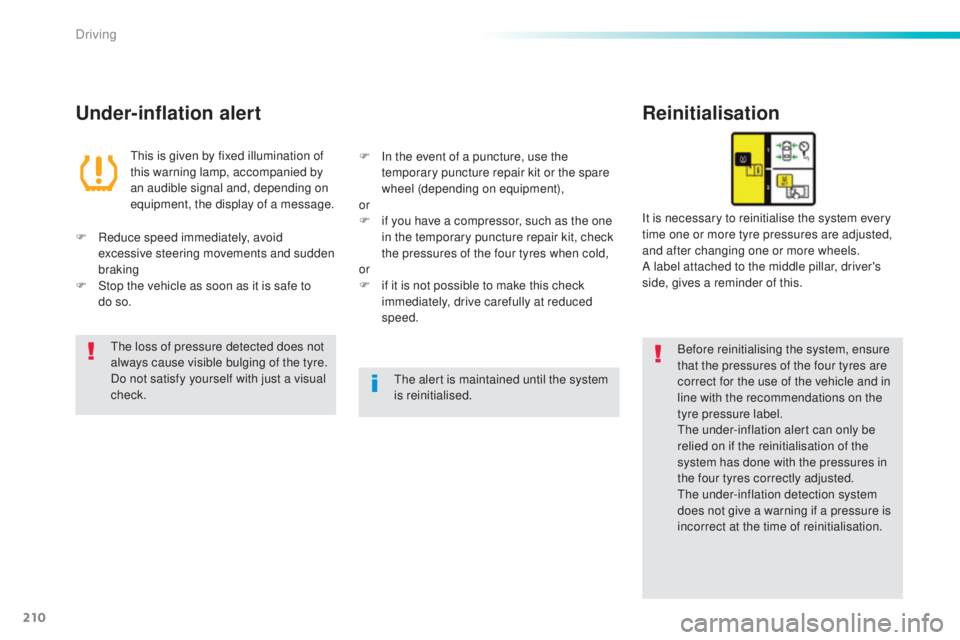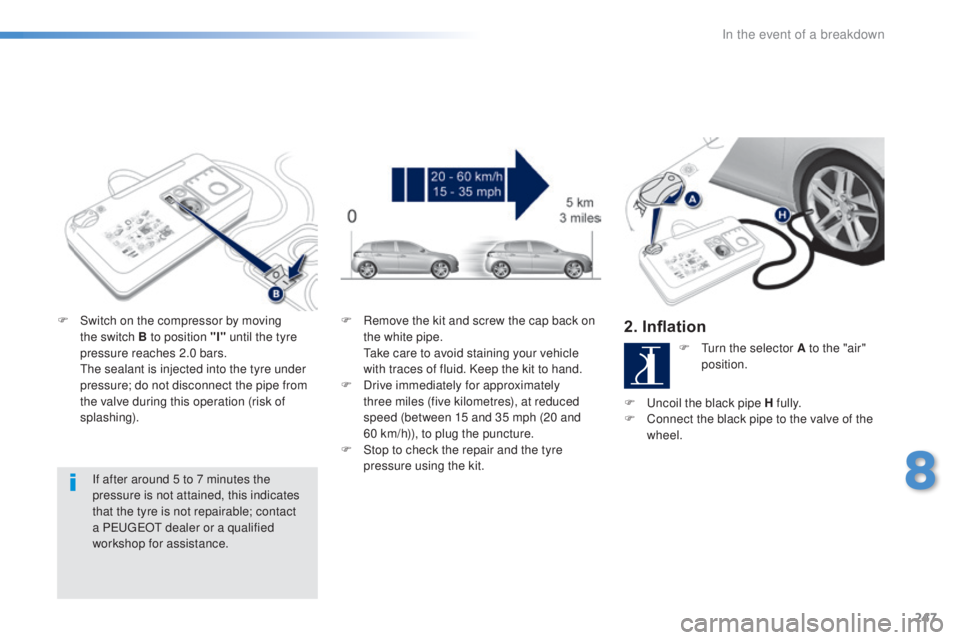Page 6 of 398

4
308_en_Chap00b_vue-ensemble_ed02-2015
exterior
W i p e r s 115 -118
Changing a wiper blade 11 8, 222
Keyless
ent
ry and Starting remote
control
54
-58, 61- 63
Remote control key
48
-53, 63
Starting
14
8-154
elec
tronic stability
control (
eS
C)
120
-12 2
Snow chains
21
6
tyr
e pressures
24
4, 255, 295
Inder-inflation detection
209
-212
Changing a wheel
25
0-255
-
t
ools
-
re
moving / refitting
Automatic emergency braking
19
0-194
Lighting
1
08-114
Daytime running lamps (L
eDs
)
11
2
Headlamp beam adjustment
11
4
Changing bulbs
25
6-260
- fr ont lamps
- fo glamps
-
di
rection indicator repeaters
Very cold climate screen
21
7
ele
ctric windows, deactivation
69
-70
Keyless
ent
ry and Starting
54
-58
Doors
48
-50, 52
-
open
ing / closing
-
ce
ntral locking
-
emer
gency control
Alarm
6
5-68
Fuel tank, misfuel prevention
21
3-215
Panoramic sunroof
10
3
Roof bars, bicycle carrier
22
3 -224
Accessories
22
0-221
Boot
5
9-60
-
open
ing / closing
-
emer
gency release
tem
porary puncture repair kit
24
4-249
Warning triangle
24
3
Parking sensors
19
8-199
Reversing camera
20
0
tow
bar
14
7, 218
tow
ing
27
5 -276
Park Assist
20
1-208
Changing bulbs
26
1-265
-
re
ar lamps
-
3rd brake lamp
- nu mber plate lamps
-
fo
glamp Door mirrors
10
6, 114
Blind spot sensors
19
5 -197
Over view
Page 26 of 398

24
Engine oil
pressurefixed.the
re is a fault with the engine
lubrication system. You must stop as soon it is safe to do so.
Park, switch off the ignition and contact a Peu
geOt
d
ealer or a qualified workshop.
Deflated tyre fixed.
the p
ressure in one or more tyres is
too low. Check the pressures of the tyres as soon as possible.
thi
s check should preferably carried out with the tyres
cold.
flashing then fixed.
the u
nder-inflation detection system
has a fault. Have it checked by a P
eu
ge
Ot d
ealer or a qualified
workshop.
For more information on under-inflation detection,
refer to the corresponding section.
Warning
/
indicator lamp
State Cause Action
/
Observations
Foot on the
brake pedal fixed.
the b
rake pedal must be pressed. With an automatic gearbox, press the brake pedal, engine running, before releasing the parking brake, to
unlock the lever and come out of position P .
If you wish to release the parking brake without
pressing the brake pedal, this warning lamp will
remain on.
Foot on the
clutch fixed.
In the S
tOP m
ode of Stop & Start,
changing to S
tARt m
ode is refused
because the clutch pedal is not fully
down. You must declutch fully to allow the change to engine
S
tA
R
t m o
d e .
Instruments
Page 211 of 398

209
308_en_Chap06_conduite_ed02-2015
Under-inflation detection
the system monitors the pressures in the
f our t yres, once the vehicle is moving.
It compares the information given by the four
wheel speed sensors with reference values,
which must be reinitialised ever y time the
tyre pressures are adjusted or a wheel
changed .
the s
ystem triggers an alert as soon as it
detects a drop in the inflation pressure of one
or more tyres.the u nder-inflation detection system
does not replace the need for vigilance
on the part of the driver.
thi
s system does not avoid the need to
check the tyre pressures (including the
spare wheel) every month as well as
before a long journey.
Driving with under-inflated tyres impairs
road holding, extends braking distances
and causes premature tyre wear,
particularly under arduous condition
(high loading, high speed, long journey).
System which automatically checks the pressures of the tyres while driving.the i
nflation pressures defined for
your vehicle can be found on the tyre
pressure label.
For more information on the
identification markings, refer to the
corresponding section.
tyr
e pressures should be checked
when the tyres are "cold" (vehicle
stopped for 1 hour or after a journey of
less than 6 miles (10 km) at moderate
speeds).
Other wise (when hot), add 0.3 bar to
the pressures shown on the label.
Driving with under-inflated tyres
increases fuel consumption.
Snow chains
the system does not have to be
r einitialised after fitting or removing
snow chains.
6
Driving
Page 212 of 398

210
308_en_Chap06_conduite_ed02-2015
Under-inflation alertReinitialisation
Before reinitialising the system, ensure
that the pressures of the four tyres are
correct for the use of the vehicle and in
line with the recommendations on the
tyre pressure label.
the u
nder-inflation alert can only be
relied on if the reinitialisation of the
system has done with the pressures in
the four tyres correctly adjusted.
the u
nder-inflation detection system
does not give a warning if a pressure is
incorrect at the time of reinitialisation.
thi
s is given by fixed illumination of
this warning lamp, accompanied by
an audible signal and, depending on
equipment, the display of a message. It is necessary to reinitialise the system every
time one or more tyre pressures are adjusted,
and after changing one or more wheels.
A label attached to the middle pillar, driver's
side, gives a reminder of this.
F
Red
uce speed immediately, avoid
excessive steering movements and sudden
braking
F
St
op the vehicle as soon as it is safe to
do
s
o. F
In t
he event of a puncture, use the
temporary puncture repair kit or the spare
wheel (depending on equipment),
or
F
if y
ou have a compressor, such as the one
in the temporary puncture repair kit, check
the pressures of the four tyres when cold,
or
F
if i
t is not possible to make this check
immediately, drive carefully at reduced
speed.the l
oss of pressure detected does not
always cause visible bulging of the tyre.
Do not satisfy yourself with just a visual
check.
the a
lert is maintained until the system
is reinitialised.
Driving
Page 213 of 398

211
308_en_Chap06_conduite_ed02-2015
Reinitialisation of the system is done with the
ignition on and the vehicle stationary.F
Pr
ess "Under-inflation
initialisation ".
F
Co
nfirm the instruction by pressing " Ye s",
an audible signal and a message confirm
the reinitialisation.
Touch screen
the new pressure settings registered
a re considered to be reference values
by the system.
Screen C
F Press the MENU b utton for access to the
main menu.
F
Pr
ess the " 7" or " 8" buttons to select the
Personalisation-configuration menu,
then confirm by pressing the OK button.
From the "Driving assistance " menu
of the touch screen:
F Press the " 5" o r "6 " button to select the
Define the vehicle parameters menu,
then confirm by pressing the OK button.
F
Pr
ess the " 5" or " 6" button to select the
Driving assistance menu, then the Ty r e
pressures menu, then the Reinitialisation
menu, then confirming by pressing the OK
button.
An a
udible signal confirms the
reinitialisation.
6
Driving
Page 214 of 398
212
308_en_Chap06_conduite_ed02-2015
F With the ignition on and the
vehicle stationary, press this
button for about 3 seconds then
release it, an audible signal
confirms the reinitialisation.
Screen A Operating fault
the flashing and then fixed illumination of the
u nder-inflation warning lamp accompanied
by illumination of the Service warning lamp
indicates a fault with the system.
In this case, under-inflation monitoring of the
tyres is no longer assured.
Have the system checked by a P
eu
ge
Ot
d
ealer or a qualified workshop. Before doing anything to the system,
the pressures of the four tyres must be
checked and the system reinitialised.
Screen A (without audio system)
Driving
Page 246 of 398

244
308_en_Chap08_en-cas-de-panne_ed02-2015
this kit is installed in the storage box, under the
bo ot floor.
thi
s kit consists of a compressor and a sealant
cartridge.
It allows the temporary repair of a tyre.
You are then able to go to the nearest garage.
It is designed to repair most punctures which
could affect the tyre, located on the tyre tread
or shoulder.
Its compressor can be used to check and
adjust the pressure of the tyre.
temporary puncture repair kit
Access to the kit
List of tools
these tools are specific to your vehicle and can
v ary according to equipment. Do not use them
for other purposes.
1.
12 V c
ompressor.
Co
ntains a sealant cartridge for the
temporary repair of a tyre and can also be
used for adjusting tyre pressures.
2.
tow
ing eye.
the t
yre inflation pressures are given on
this lab el.
the v
ehicle's electric system allows the
connection of a compressor for long
enough to inflate a tyre after a puncture
repair or for inflating a small inflatable
accessory.
For more information on towing refer to
the corresponding section.
In the event of a breakdown
Page 249 of 398

247
308_en_Chap08_en-cas-de-panne_ed02-2015
If after around 5 to 7 minutes the
pressure is not attained, this indicates
that the tyre is not repairable; contact
a P
eu
ge
Ot d
ealer or a qualified
workshop for assistance.
F
Sw
itch on the compressor by moving
the switch B to position "I" until the tyre
pressure reaches 2.0 bars.
the s
ealant is injected into the tyre under
pressure; do not disconnect the pipe from
the valve during this operation (risk of
splashing). F
Re
move the kit and screw the cap back on
the white pipe.
tak
e care to avoid staining your vehicle
with traces of fluid. Keep the kit to hand.
F
Dr
ive immediately for approximately
three miles (five kilometres), at reduced
speed (between 15 and 35 mph (20 and
60
k
m/h)), to plug the puncture.
F
St
op to check the repair and the tyre
pressure using the kit.
2. Inflation
F turn the selector A to the "air"
p osition.
F
u
nc
oil the black pipe H fully.
F
Co
nnect the black pipe to the valve of the
wheel.
8
In the event of a breakdown